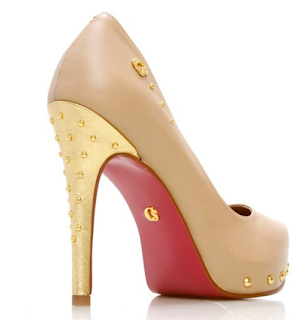But let's get serious. Customers are shelling out the big bucks not for the shoe itself (as devlishly beautiful as they may be) or anything physical in nature, but for the red sole. More specifically, and as is the norm for most luxury goods, consumers are paying for what these shoes represent. Like a beacon of show-stopping light, these shoes sit on top of a foundation that symbolizes glamor, wealth, and prestige, which is exactly what consumers are paying for. Sure, they're beautiful and structurally complementing, but would consumers really be willing to buy the shoes, at the same price, without the red sole? They, like many other totems in the industry, are a part of a collective that allow individuals entry into a world of exclusivity. It's the brands that make the consumer world go 'round, not so much the products.
For this precise reason, Louboutin has decided to take action and protect its precious trademark against the house of Yves Saint Laurent and Carmen Steffens for their use of la semelle rouge, the specific hue of red painted on the soles of his shoes. Back in 2008, Louboutin's attorney's secured the rights to using la semelle rouge on the soles of shoes in the U.S. and 75 other countries. It is, however, a bit odd that Louboutin decided to secure the rights to the specific color then, as he has been painting the bottoms of his shoes since 1993. As a result, his actions may prove to be too little, too late, as other companies (mentioned above) have been making their very own red-soled shoes as well. Mark Willingham, president of U.S. operations for Carmen Steffens, mentioned that red, along with a whole spectrum of other colors, is theirs to use. "Over the years, we've incorporated various tones of red. It's part of our brand's DNA."
| Yves Saint Laurent Palais 150 |
 |
| Carmen Steffens Carlota CS |
Above: The alleged copyright culprits (Yves Saint Laurent Palais 150 and Carmen Steffens Carlota CS, respectively)
International Trademark Association executive director, Alan C. Drewsen, makes a good point, that although the subject matter may seem petty, if "Louboutin fails to protect his trademark now, imitators may eventually leave him with nothing to protect at all. 'Aspirin and Cellophane' were once trademarks that weren't adequately defended. Now they're generic". The other aspect pertaining to the issue concerns the color itself, and the power behind it in shaping a company's brand. Michael Shaw, a patent attorney with the London intellectual-property firm of Marks & Clerk, the process of trademarking a color is not an easy one. "It [must] be shown that the color has acquired a highly distinctive character as a result of substantial use." Rare examples of this include the robin's egg blue of Tiffany & Co., as well as Owens Corning's mark for pink fiberglass insulation. New York Law School professor Dan Hunter sates that, "generally speaking, colors don't function as trademarks. But they can with enough use, enough marketing, and enough consumer recognition. Which is what happened with red-soled Louboutin shoes." Granted, Louboutin's red sole is the only physically visible signature of his brand that consumers can recognize from near and far. Yes, he has a distinctive company logo and signature, but what purpose does that serve when it is branded on the insoles of the shoes? Consumers would have to take their heels off in order to showcase their association with the brand (and all it's subsequent associations (ex. wealth, class, etc.)), which would then deny them the ability to show off while actually wearing the shoes.
As mentioned previously, consumers are mostly purchasing the brand and its associations instead of the actual shoes. Milton Pedraza, CEO of the Luxury Institute says, "I talked to a very successful businesswoman about this the other day, and she said, 'of course that red sole matters. It signals to the world that I wear Louboutins - a top-of-the-line shoe. It [says] i'm a successful woman, and I bought these myself, that i'm powerful - and still feminine." Pedraza goes on to say, "that sole has a lot of messaging embedded in it. It's about the emancipation of women in the corporate suit".
Red soles, of that particular color, are understandable, but I honestly don't see a reason to pursue legal action when it comes to the YSL's, as it wouldn't be the first time that red has been featured in a pair of shoes in their entirety (hello, Dorothy of Oz?) I suppose, however, that Louboutin must fiercely fight for everything that consumers see when it comes to his shoes, and that includes the specific red pigment, regardless of how and where it is featured.
- Lance

No comments:
Post a Comment